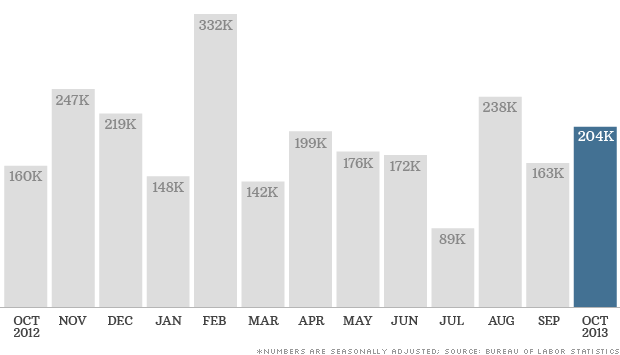Author: Annalyn
Kurtz
Date of article: November
8, 2013
Website: CNN Money
Everyone
predicted the economy to fall drastically after the 16 days of little
government interaction due to the shutdown but surprisingly the economy was not
hit that hard with the freeze, in fact, it increased activity. According to the
Bureau of Labor Statistics, 204000 new jobs were added to the U.S. economy in
the month of October. This number was surprising to economists’ expectation for
the month. This number is a huge leap from the late August and September hiring
stat of 60,000.
 The
article puts it bluntly: “Economists were
expecting weak job growth due to uncertainties created by the budget battles in
Washington. The federal government shut down on Oct. 1, after Congress failed
to agree on a budget for fiscal 2014. The standoff lasted 16 days and left as
many as 800,000 federal employees temporarily out of work.” The
numbers were also strong enough to get Wall Street talking once again about
when the Federal Reserve should start slowing its stimulus program. The Fed has
been buying $85 billion in bonds each month since September 2012, in an effort
to strengthen the job market.
The
article puts it bluntly: “Economists were
expecting weak job growth due to uncertainties created by the budget battles in
Washington. The federal government shut down on Oct. 1, after Congress failed
to agree on a budget for fiscal 2014. The standoff lasted 16 days and left as
many as 800,000 federal employees temporarily out of work.” The
numbers were also strong enough to get Wall Street talking once again about
when the Federal Reserve should start slowing its stimulus program. The Fed has
been buying $85 billion in bonds each month since September 2012, in an effort
to strengthen the job market.
Given the
government shutdown, many Fed watchers were starting to think the central bank
would continue its stimulus at full blast until at least spring 2014. The Fed
next meets at the end of December, and the strong jobs report could mean
officials will consider reducing their monthly bond purchases sooner rather
than later. "Once again the U.S. economy appears to be overcoming a summer
swoon," said Paul Ashworth, chief U.S. economist for Capital Economics in
a research note. "In our opinion, the data would justify the Fed reducing
the pace of its asset purchases in December."
The
outlook isn't all rosy though. Overall, the economy has still not recovered all
of the jobs lost in the Great Recession. The jobs report also showed the
unemployment rate rose slightly to 7.3%, up from 7.2% in September, but
economists expect this to be a passing blip. About 448,000 furloughed federal
workers were counted as being on temporary layoff, and the next jobs report,
due on December 6, will probably show these people were back at work in
November.
Meanwhile,
only 62.8% of Americans over age 16 either had a job or looked for one. That's
the lowest level since March 1978. Economists also believe this number was
impacted by furloughed federal employees but nevertheless, it has been hovering
around the lowest levels since the 1970s for months. Where are the jobs? Job
gains came across a variety of sectors. Retailers added 44,000 jobs,
professional and business services also added 44,000 jobs, restaurants and bars
hired 29,000 workers and manufacturers added 12,000 jobs. Meanwhile, the
federal government cut 12,000 jobs -- a third of which were at the U.S. Postal
Service.